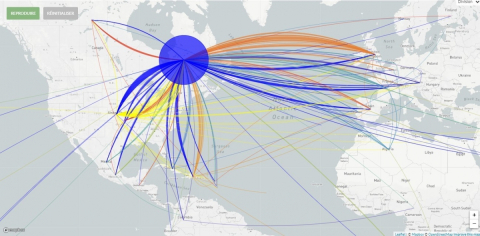First genetic sequencing of COVID in Quebec shows roots of outbreak

Initial results of study show that an estimated 250 independent events following spring break travel in March led to 60,000 people being infected
September 21, 2020 (MONTREAL, Quebec) – Today the Institut national de santé publique du Québec (INSPQ) and the McGill Genome Centre announced the initial results of their study into the genetic sequencing of the SARS-CoV-2 genome, the virus responsible for the outbreak of COVID-19. According to the study, the virus entered Quebec during the spring break period and could have been carried into the province by as few as 247 people. Peer review of this preliminary study is pending.
“Our research indicates that origin of the outbreak in Quebec was mostly via Europe and the Americas, and not from Asia,” said Dr. Jesse Shapiro, Associate Professor, Department of Microbiology and Immunology. “Most of the early introductions of the virus into Quebec did not give rise to sustained transmission, but a barrage of introductions just after spring break eventually gave rise to the tens of thousands of cases we have seen since.”
The team sequenced and analyzed 734 high-quality genome sequences obtained between mid-February and April 1, 2020. The sequences were placed these in the context of 21,935 sequences from elsewhere in Canada and internationally, including all available in the Global Initiative on Sharing All Influenza Data (GISAID), up to April 1st. The researchers looked for the geographical origins of the various introductions by comparing the results of epidemiological travel-history data with phylogenetic inference and ancestral state reconstruction (also referred to as ASR, or the extrapolation back in time from measured characteristics of individuals to their common ancestors).
“We used multiple cutting-edge genomic technologies to sequence the entire SARS CoVid-2 genome,” said Dr. Ioannis Ragoussis, Professor, Department for Human Genetics and Head of Genome Sciences at McGill University. “Although our findings are preliminary, thanks to these techniques we have high confidence in the data.”
Within the dataset examined by the team, travel-history data suggested that nearly one third of infections (32.7%) came from Europe (with France having the highest amount at 12.1%), 31% originated from the Caribbean/Latin America, and nearly one quarter were derived from the USA (23.9%). Few introductions came from Asia (1.2%) and none from China. This confirms the notion that COVID had spread much more widely than earlier believed and that by the early spring of 2020 it was much more than an endemic disease in China. Indeed, based on the phylogeny of the earliest reported cases, it is possible the first case reached Quebec City from the United Kingdom as early as January 30 – but the precise date is still not known with certainty.
“The data confirms the importance of public health measures,” said Dr. Sandrine Moriera, Head of Genomics and Bioinformatics, Institut national de santé publique du Québec. “With such few cases leading to community-based transmission, we all need to remain vigilant.”
“This is the first of many analyses that will look not only at how the virus was first introduced into the province but also at how it has been spreading,” said Dr. Guillaume Bourque, Professor, Department for Human Genetics and Head of the Canadian Center for Computational Genomics. “Indeed, it is surprising to see how widely the virus had been dispersed at such an early stage.”
The data also shows that in the early stages of the outbreak, there was a high concentration of cases in the Monteregie region of Quebec. Data also suggest that both Latin American, and US cases also had European origins. The study is available online. Studies on the phylodynamics, or the evolution, of the SARS CoVid-2 virus will continue.
##
About the McGill Genome Centre
The Centre advances genomics in medical research and traces its history to the founding of its predecessor, the McGill University and Génome Québec Innovation Centre in 2002. It provides a cutting-edge integrated research environment that harnesses the most recent advances in genomics and other areas of large-scale biology, with quantitative methodology and computational analysis for breakthroughs in medical and life sciences research. Currently, the Centre houses more than 215 faculty members, other staff and students who work on independent research projects or help to operate our platforms. To find out more, visit www.mcgillgenomecentre.ca
About McGill University
Founded in Montreal, Quebec, in 1821, McGill is a leading Canadian post-secondary institution. It has two campuses, 11 faculties, 13 professional schools, 300 programs of study and over 40,000 students, including more than 10,200 graduate students. McGill attracts students from over 150 countries around the world, its 12,800 international students making up 31% per cent of the student body. Over half of McGill students claim a first language other than English, including approximately 19% of our students who say French is their mother tongue.
Media contacts
|
(English) Dr. Jesse Shapiro Associate Professor Department of Microbiology and Immunology McGill University jesse.shapiro [at] mcgill.ca |
(French) Dr. Sandrine Moreira 514 864-5185 |